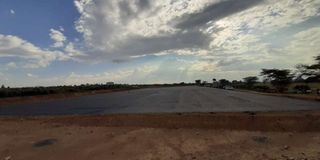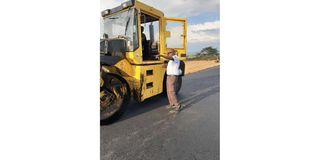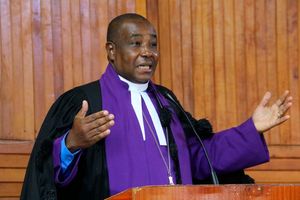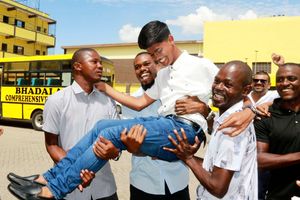Premium
WRC Safari Rally more than merely competition as rich legacy will benefit Kenya

A general view of the WRC Safari Rally Service Park at the Kenya Wildlife Service Training College in Naivasha.
What you need to know:
- More importantly, the legacy programmes therefrom will be celebrated by generations to come.
- Todt is no stranger to Kenya, having tackled the Safari Rally in the 1980s, famously as a navigator for Peugeot, so I’d simply say: Karibu tena nyumbani, Bwana Safari!
Whenever a nation, or city, bids to host a major sports competition, one of the most important aspects of such bid is the legacy programme.
Owing to the expensive and expansive nature of, especially, global competition, one of the bidding team’s key pillars is formulating a rich and sustainable legacy programme.
As not all citizens, or residents - especially those conservative and not inclined to sports - would approve the hosting of mega sports events in their locale, legacy programmes help win over such sceptics and critics alike.
The London 2012 Olympic Games, for instance, bequeathed on Londoners the public Queen Elizabeth Olympic Park in Stratford, East London, which was the nerve centre of the Games and which is now run by the London Legacy Development Corporation.
Over two billion pounds (almost Sh300 billion) was ploughed into the park transformation programme alongside a youth sports strategy and funding of the English Federation of Disability Sports as part of London’s legacy programme.

Anthony Gatei, the WRC Safari Rally Service Park Manager, supervises the tarmacking of the Service Park at the Kenya Wildlife Service Training College in Naivasha on November 21, 2020.
The benefits of the Qatar 2022 Fifa World Cup are already being felt with cooling technology developed by Doha to counter the Gulf’s heat and humidity during the football showpiece already being adopted at venues outside Qatar.
And with all eight World Cup stadiums connected by a special transport network enabling fans to - for the first time in World Cup history – watch two matches in one day, Qataris will benefit from a modern public transport system way beyond the 2022 World Cup finals.
Equally, benefits of the WRC Safari Rally will transcend the battle for speed on Kenyan roads.
International Automobile Federation (FIA) President Jean Todt arrives in Nairobi today for a significant visit which he will launch with a symbolic tree-planting ceremony at Kasarani along with Sports Cabinet Secretary Amina Mohamed, Principal Secretary Joe Okudo, WRC Safari Rally CEO Phineas Kimathi and other dignitaries.
When Todt and co. plant the Acacia Xanthophoea (Yellow Fever Tree) just after midday, they will have launched a significant journey in which WRC Safari Rally organisers aim to plant 19 million trees over the next three years under the “WRC Safari Rally Greening Legacy Project” programme.
This symbolises the 19 years Kenya has been out of the WRC roster.
More importantly, the gesture will significantly help improve Kenya’s green cover, a worthy legacy from hosting a WRC round.
Environmental issues aside, the WRC Safari Rally also aims at helping create awareness on road safety.
As the United Nations Secretary General Special Envoy for Road Safety, Todt will also hold a series of side meetings at the United Nation’s Nairobi offices with a view to amplifying safety on our roads.
With approximately 3,500 people killed on the roads, worldwide, each day, and with road accidents projected to soon become the number one cause of death, Todt sees the WRC circuit as an appropriate platform to appeal for improved road safety.
“Together with its 245 member organisations around the world, the FIA is on the frontline in tackling this challenge,” Todt says in the “FIA Action for Road Safety” campaign programme.
“Everyone has a role to play in making safer roads for all. Individuals have a personal responsibility to behave safely on the roads,” he throws down the gauntlet.
Globally, 13 top sports stars have enlisted with the FIA campaign, including track and field superstars Haile Gebrselassie, Johan Blake, Wayde van Niekerk, tennis legend Rafael Nadal along with Formula One drivers Nico Roseberg, Fernando Alonso and Felipe Massa.
Gladly, Kenyans have already taken up Todt’s challenge with a vibrant team of young WRC Safari Rally volunteers, including marshalls, drumming up the hashtag #TufikeSalama (let’s arrive safely).
With the WRC Safari Rally’s Service Park at the Kenya Wildlife Service Training Institute in Naivasha, benefits accruing from the annual WRC round will be felt for years to come.
Service Park manager Anthony Gatei has spent sleepless nights improving rallying infrastructure at the institute.
Already, a 220 by 90 metres surface has been tarmacked as the heart of the Service Park which can then be used for various other purposes, such as a parade ground and graduation square for KWS servicemen, a motor show arena or karting circuit.
Or even a ground for “drifting” which has become popular among young drivers and which the Kenya Motor Sports Federation to hopes use to further popularise the sport within the confines of safety.
This also means additional revenues to run KWS conservation programmes.
Fire break roads at the KWS institute – which, incidentally, is in the process of being elevated to a KWS Training and Research Institute, with a director in charge rather than principal – have also been upgraded.
Locals around Naivasha are already feeling the positive WRC vibe with increased hotel bookings and with youths lined up for roles as volunteer marshalls.
With an estimated Sh6 billion projected to be pumped into the Kenyan economy by the WRC, the efforts by Kimathi and his Safari Rally team to win back recognition from the FIA have certainly borne fruit.
More importantly, the legacy programmes therefrom will be celebrated by generations to come.
Todt is no stranger to Kenya, having tackled the Safari Rally in the 1980s, famously as a navigator for Peugeot, so I’d simply say: Karibu tena nyumbani, Bwana Safari!




